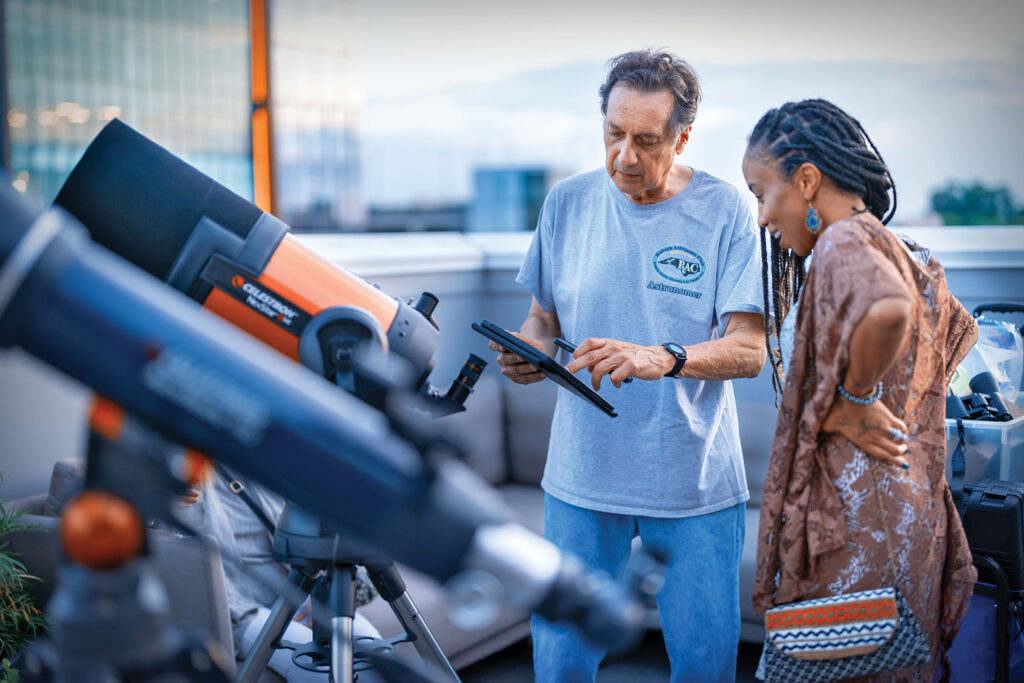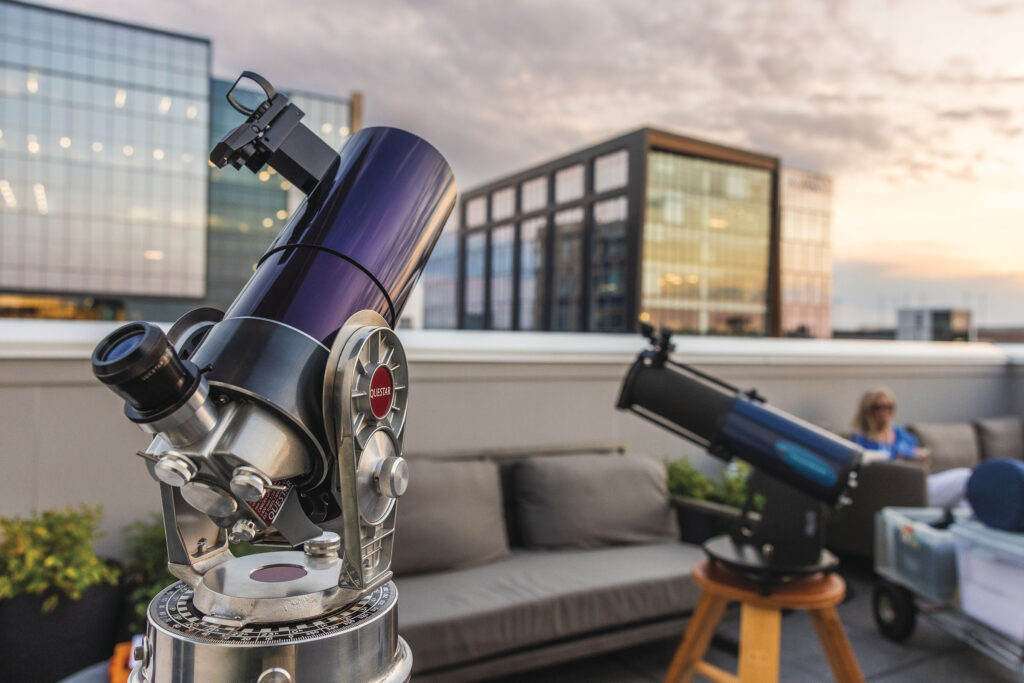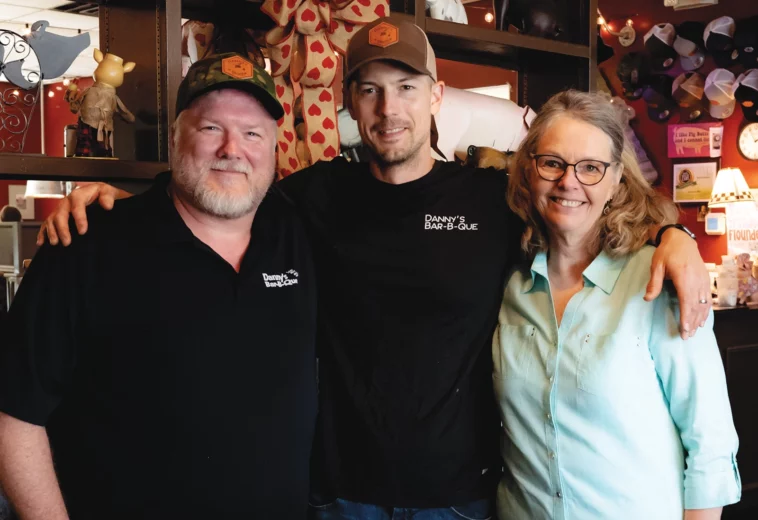Article:
Stargazing in the Triangle
BY MARIO BOUCHER | PHOTOS BY BRUCE DeBOER (unless otherwise noted)
Stargazing offers us an opportunity to look up at the marvels of stars and planets. Jonathan Pishney, head of communications at the North Carolina Museum of Natural Sciences’ Nature Research Center in Raleigh, reminds us that astronaut training isn’t necessary to appreciate what makes space so cool. “I fell in love with astronomy in grade school, when one of my teachers would gather students on the playground at night and let us look through a couple of telescopes,” he says. “I was so amazed at how many more stars were in the sky that you couldn’t really see with the naked eye. A telescope showed so much more.”
Those early educational experiences paved the way for Pishney’s lifelong love of space. “From there, I started learning—way before the internet was a thing—about constellations and the different star names, as well as the moon and planets,” he says. “It was fun to share that knowledge with my daughter as she was growing up.”
Nick Eakes, a science education specialist at Morehead Planetarium and Science Center in Chapel Hill—and native of the town—attended UNC–Chapel Hill and has been involved with the planetarium for 16 years, thanks to working there as a high school volunteer. Since 2015, Eakes has coordinated both the Mobile Planetarium and Skywatching programs, which have given him the opportunity to travel to all 100 North Carolina counties in order to bring stargazing to students who may not be able to make the trip to Chapel Hill.
“Gazing up at the night sky sparks the curiosity of most people who try it. The cosmos can make us feel so small, but working to understand these distant objects brings everything a bit closer to home,” he says. “Understanding the way things work beyond our Earth helps to inform how we approach physics, chemistry, biology and much more here on our planet. People across the world have used the sky to explain their own cultural stories and the happenings of their daily lives throughout human history.”
The Great Unifier
Since 2014, Eakes has also served as a NASA JPL (Jet Propulsion Laboratory) Solar System Ambassador, hosting events and informing local communities about current NASA missions and research. “To me, this just speaks to the fact that we can look at the sky through a cultural and scientific lens at the same time,”
he says. “The night sky is a great unifier. There is a lot of value in the fact that we all are a part of a larger universe, despite our differences here on the surface.”
Bruce Betts’ interest in astronomy and space exploration since childhood led him to earn a doctorate in planetary science from the California Institute of Technology, before settling in as chief scientist and LightSail program manager with The Planetary Society, based in Los Angeles. “Even as a kid I loved staring up at the sky, enjoyed learning constellations at camp, and loved
seeing pictures of other worlds as they came back from spacecraft exploring
the solar system,” he says. “I did research studying spacecraft and telescope data of planets and moons. I managed some programs at NASA, and then I came to The Planetary Society to manage science and technology programs.”
Betts is enthusiastic about finding ways to share his love and knowledge of astronomy and space exploration with the public. “There’s always something new to look at, for the soothing experience of looking back at beautiful things you’ve already seen before,” he says. “There are so many different things that we continue to learn and discover, and so many mind-blowing facts to digest and ponder. Seeing planets, the moon or stars in the night sky can be interesting, and it can also be a profound experience to see things so far away—weird and wild.”
Eakes remembers his own personal fascination with the night sky during his childhood. “I visited Morehead [Planetarium] as a small child and was enraptured by the giant Zeiss projector in the center of the theater—creating images and moving us through the stars,” he says. “Though we’ve moved away from the Zeiss projector and on to digital projection technology, my fascination for astronomy remains. If I can inspire students of all ages in our state to simply look up and dream, I can rest easy as a small part of this beautiful universe.”

TOP OF PAGE: Melissa and Jason Wistehuff, Jason and Nancy Anderson, and Rae and Austin Hackney gather at The Willard Rooftop Lounge to enjoy celestial cocktails and views of the constellations.
ABOVE: The Raleigh Astronomy club meets monthly at the Willard Rooftop Lounge to set up telescopes so guests can view the stars, planets and galaxy.

ABOVE: Raleigh Astronomy Club member Tony Verdone shows a guest constellations that are viewable from the Willard Rooftop Lounge.
Local Stargazing Experiences
What marvels can Triangle residents see when they look up at the stars and planets? Opportunities to view constellations and craters abound—in places you might never have suspected.
Pishney lives in the city’s outskirts near Jordan Lake State Recreation Area in Apex, where less light pollution allows him to clearly see the stars and moon through a telescope. “It’s crazy to see all those craters up close,” he says. “Crazier to think of the astronauts who have set foot on the moon. And soon, perhaps a new generation of astronauts will do the same.”
Books, the internet and apps like Night Sky, SkySafari and SkyView can provide in-depth insight into what to look for in the sky. To see the moon, planets and stars brighter and clearer, a pair of astronomy binoculars can cost as little as $50 and an amateur telescope can cost $100–$300.
“An important thing to realize is that you don’t need any equipment to explore the night sky, though certainly having binoculars or telescopes will open up additional possibilities,” Betts says. “One of the best ways to get started is to just look up with your eyes and start learning constellations and stars, and look for the planets and note how they move across the sky over days, weeks and months. There are telescopes which allow you to see additional things—from the rings of Saturn to gaseous nebula.”
More can be seen 30–60 minutes away from city lights. Explore the night sky at public parks like Little River Regional Park & Natural Area in Rougemont, Eno River State Park in Durham, Jordan Lake State Recreation Area in Apex, and Falls Lake State Recreation Area in Wake Forest.
Eakes says anyone can go outside, look up and “find a clear patch of sky and wonder what is out there, free of charge. Our ‘Carolina Skies’ show at Morehead Planetarium gives an overview of the types of objects you can find in your own backyard here in North Carolina, so I recommend that program for the curious stargazers out there.”
The Nature Research Center is a wing of the North Carolina Museum of Natural Sciences in Raleigh that houses an astronomy research lab with two on-staff astronomers. Outside the lab, discover interactive computer displays highlighting the moon, sun, solar system, distant planets and stars; a moon rock collected during the Apollo 17 mission in 1972; and a lunar meteorite displayed under a microscope with changing lights to highlight the different minerals. For more information, visit naturalsciences.org.
Since 1949, Morehead Planetarium and Science Center has been on UNC‑Chapel Hill’s campus. There is a full-dome planetarium with a variety of shows and newly expanded interactive exhibits that demonstrate current scientific research at UNC. The planetarium will celebrate its 75th anniversary in 2024 with a series of community events, including a solar eclipse watch party. Learn more at moreheadplanetarium.org.
The Museum of Life and Science in Durham offers an “Aerospace” exhibit, which features space artifacts from the Apollo era such as astronauts’ space suits, a Mercury capsule that carried the first U.S. animal into orbit, a moon rock and a prototype of the Apollo 15 Lunar Lander. Learn more at lifeandscience.org/explore/aerospace.
Founded in 1978, the Raleigh Astronomy Club is a nonprofit organization promoting amateur astronomy to increase members’ knowledge and pursuit of astronomy. In 2021, membership increased to more than 400 astronomy enthusiasts. The club provides educational lectures, public observing sessions, astronomy workshops and social connections for amateurs. There are no requirements to join the Raleigh Astronomy Club, and some of the benefits include the use of club-owned telescopes. Learn more at raleighastro.org.
The Planetary Society is the world’s largest space interest group, with tens of thousands of members worldwide. Visit planetary.org for information on how to join the organization.

ABOVE: Celestial cocktails from The Willard Rooftop Lounge.
COSMIC COCKTAILS
The Willard Rooftop Lounge has shared some of the bar team’s celestial cocktail recipes for you to make at home and enjoy under your own little piece of the night sky. These cocktails were made with and perfected by input from every bartender on staff—and even took inspiration from cocktails created by past bartenders. Give these a shake and stir!
Full Moon
Ingredients
.75 ounces of vodka
.5 ounces of Hoodoo Chicory Liqueur
.5 ounces of espresso
.5 ounces of grenadine
.25 ounces of Montenegro
Directions
Stir ingredients together and pour the mixture in a coupe glass. Top it with Pepsi and garnish it with a moon-shaped ice sphere.
Limon-Stellar
Ingredients
1.5 ounces of Citrus-Cello
2 ounces of chai tea syrup
.5 ounces of lemon juice
1 bar spoon of maple syrup
Directions
Using a shaker, mix all ingredients together and pour the mixture into a sherry glass. Add ice and garnish the cocktail with spun sugar.
Galaxy Guest
Ingredients
2 ounces of Raleigh Rum Company Sweet Dark Rum
1 ounce of Coco Lopez cream of coconut
.5 ounces of simple syrup
Directions
Using a shaker, mix all ingredients together and pour the mixture into a rocks glass. Add 1-by-1-inch ice cubes. The Willard Rooftop Lounge’s bartenders garnish this cocktail with a homemade green, blue and purple sugar plate that resembles a galaxy.


ABOVE: Raleigh Astronomy Club telescopes; photo by Richard Barlow. Morehead Planetarium and Science Center; photos by Mario Boucher.
Astronomy Events to Check Out
July 24: Stargazing with Morehead Planetarium on The Durham’s rooftop.
thedurham.com/events/views-from-the-durham
August 13: Peak of Perseid meteor shower.
in-the-sky.org/news.php?id=20230813_10_100
August 19: Stargazing at the North Carolina Museum of Art.
ncartmuseum.org/events/summer-stargazing-2/?occurrence=2023-08-19
August 27: Saturn is at opposition of the sun, appearing brighter and larger.
in-the-sky.org/news.php?id=20230827_12_100
August 31: The Raleigh Astronomy Club will stargaze from The Willard Rooftop Lounge, which will offer celestial-inspired cocktails during this free event. thewillardraleigh.com/happenings/stargazing
October 14: The North Carolina Museum of Natural Sciences will host a solar observing session for the partial solar eclipse with, potentially, two telescopes (H-alpha and white light) so guests can see different layers of the solar atmosphere.
timeanddate.com/eclipse/in/usa/raleigh
Meteor showers
Perseids (peak August 12–13)
Draconids (peak October 8–9),
Orionids (peak October 22)
Leonids (peak November 18)
Geminids (peak December 13–14)
Ursids (peak December 22).



